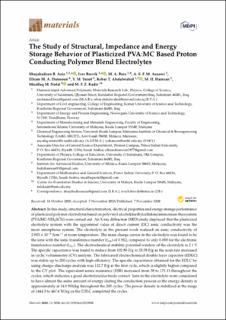| dc.contributor.author | Aziz, S. B. | |
| dc.contributor.author | Brevik, Iver Håkon | |
| dc.contributor.author | Brza, M. A. | |
| dc.contributor.author | Asnawi, A. S. F. M. | |
| dc.contributor.author | Dannoun, E. M. A. | |
| dc.contributor.author | Yusof, Y. M. | |
| dc.contributor.author | Abdulwahid, R. T. | |
| dc.contributor.author | Hamsan, M. H. | |
| dc.contributor.author | Nofal, M. M. | |
| dc.contributor.author | Kadir, M. F. Z. | |
| dc.date.accessioned | 2021-01-07T12:14:21Z | |
| dc.date.available | 2021-01-07T12:14:21Z | |
| dc.date.created | 2020-11-07T16:31:39Z | |
| dc.date.issued | 2020 | |
| dc.identifier.citation | Materials. 2020, 13 (21), . | en_US |
| dc.identifier.issn | 1996-1944 | |
| dc.identifier.uri | https://hdl.handle.net/11250/2722009 | |
| dc.description.abstract | In this study, structural characterization, electrical properties and energy storage performance of plasticized polymer electrolytes based on polyvinyl alcohol/methylcellulose/ammonium thiocyanate (PVA/MC-NH4SCN) were carried out. An X-ray diffraction (XRD) study displayed that the plasticized electrolyte system with the uppermost value of direct current (DC) ionic conductivity was the most amorphous system. The electrolyte in the present work realized an ionic conductivity of 2.903 × 10−3 Scm−1 at room temperature. The main charge carrier in the electrolyte was found to be the ions with the ionic transference number (tion) of 0.912, compared to only 0.088 for the electronic transference number (telec). The electrochemical stability potential window of the electrolyte is 2.1 V. The specific capacitance was found to reduce from 102.88 F/g to 28.58 F/g as the scan rate increased in cyclic voltammetry (CV) analysis. The fabricated electrochemical double layer capacitor (EDLC) was stable up to 200 cycles with high efficiency. The specific capacitance obtained for the EDLC by using charge–discharge analysis was 132.7 F/g at the first cycle, which is slightly higher compared to the CV plot. The equivalent series resistance (ESR) increased from 58 to 171 Ω throughout the cycles, which indicates a good electrolyte/electrode contact. Ions in the electrolyte were considered to have almost the same amount of energy during the conduction process as the energy density is approximately at 14.0 Wh/kg throughout the 200 cycles. The power density is stabilized at the range of 1444.3 to 467.6 W/kg as the EDLC completed the cycles | en_US |
| dc.language.iso | eng | en_US |
| dc.publisher | MDPI | en_US |
| dc.rights | Navngivelse 4.0 Internasjonal | * |
| dc.rights.uri | http://creativecommons.org/licenses/by/4.0/deed.no | * |
| dc.title | The study of structural, impedance and energy storage behavior of plasticized PVA:MC based proton conducting polymer blend electrolytes | en_US |
| dc.type | Peer reviewed | en_US |
| dc.type | Journal article | en_US |
| dc.description.version | publishedVersion | en_US |
| dc.source.pagenumber | 20 | en_US |
| dc.source.volume | 13 | en_US |
| dc.source.journal | Materials | en_US |
| dc.source.issue | 21 | en_US |
| dc.identifier.doi | 10.3390/ma13215030 | |
| dc.identifier.cristin | 1845857 | |
| dc.description.localcode | © 2020 by the authors. Licensee MDPI, Basel, Switzerland. This article is an open access article distributed under the terms and conditions of the Creative Commons Attribution (CC BY) license (http://creativecommons.org/licenses/by/4.0/) | en_US |
| cristin.ispublished | true | |
| cristin.fulltext | original | |
| cristin.qualitycode | 1 | |

